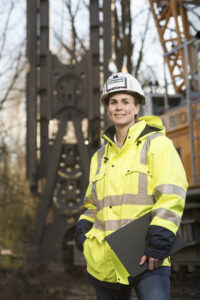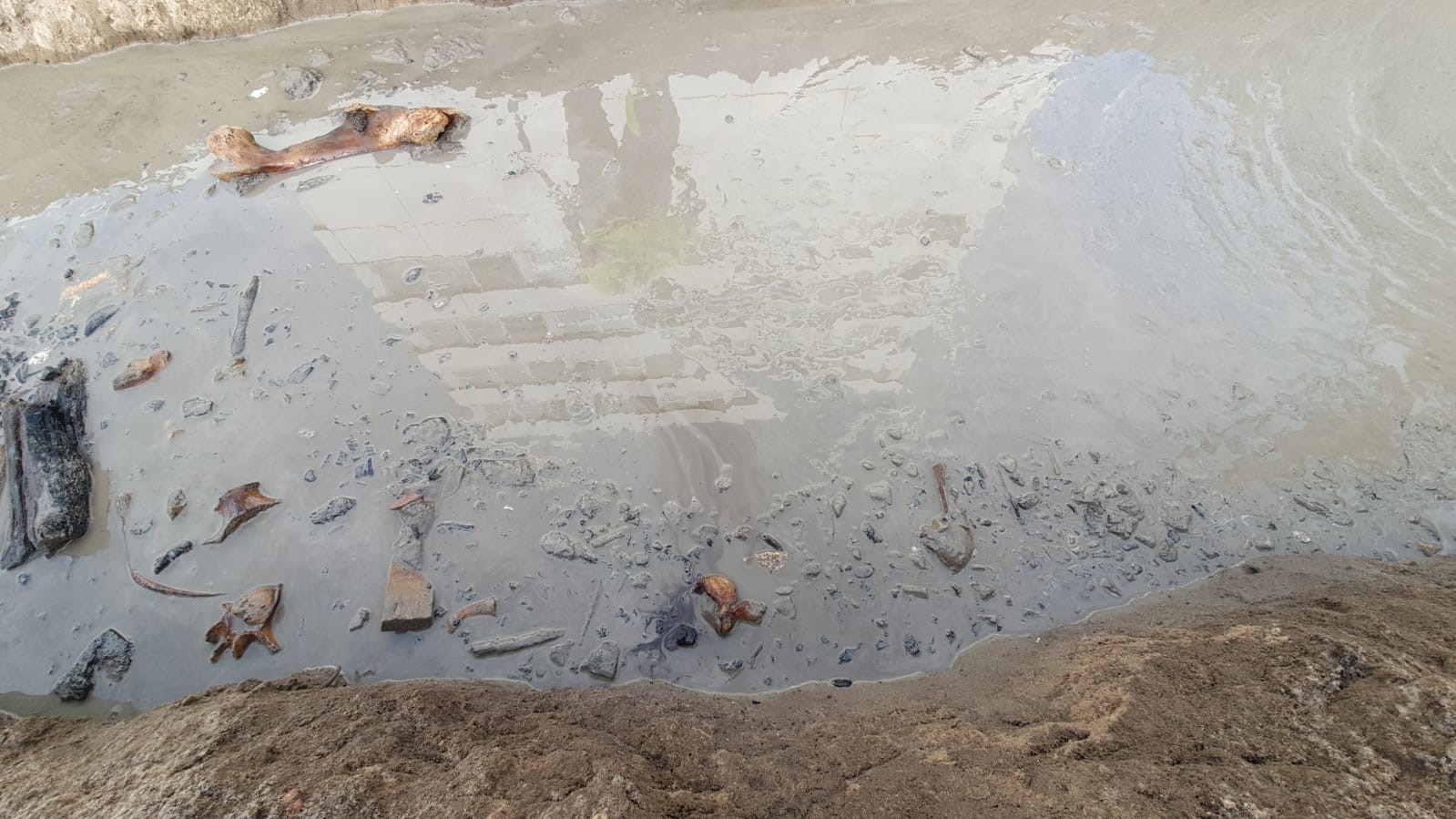A German proverb says „On the back of a horse, true happiness can be found.“ It should rather read ‘Unhappy horses lie under the ground’. One of these horses was disturbed in its last rest and brought to the surface by Hendrike Gramatke. eguana asked the construction manager at Stump-Franki Spezialtiefbau GmbH what else is hidden in the Berlin underground – and why she cannot get past beautiful gemstones despite the conscious decision to work in a male domain.
*****
Hendrike is currently working with jet grouting, DSV or HDI for short (high pressure injection) in Berlin in an injection team. In this process, a water-cement suspension is pumped into the ground at a very high pressure of around 350 bar. “Imagine this: 1bar is 10m water column, 1bar corresponds to the pressure of diving 10m deep,” explains Hendrike. “The suspension is injected into the ground with a rotating rod with one or more nozzles on the side,” while the injection is slowly pushed upwards, “which usually creates a cylinder-like body.” This strengthens the foundations and/ or limits the flow of water. If you string together many columns with an overcut, a DSV sole is created.
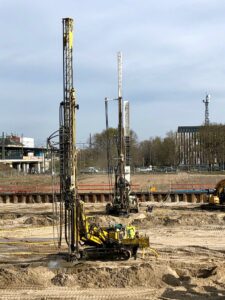
“First of all, we drill into the depth in which the base or column is to be produced. The path for the boom is cleared with relatively little pressure. When you encounter an obstacle, you don’t know whether it’s a stone or something else“ says Hendrike. You notice if an obstacle is particularly hard, but you cannot differentiate between similar materials. “At the final depth, we apply pressure. Suspension is then pumped into the ground at around 350 bar or more and all of the material in the corresponding area is rinsed out. “

A former boss once said to her: “Doctors and civil engineering specialists have one thing in common: their malpractice is buried underground.” But there are other things that lie underground, as Hendrike has realised several times.
Sticks and stones and bones
When rinsing, different things are pumped up, some of which have stuck in her mind. “At some point there was a thigh bone.” A return is normally not particularly exciting, a gray soup – the bone was noticeable just because of its shape. After a rinse with clear water it was obvious – a thigh! It was followed by a rib, the rib was followed by a pelvic bone. “There was a bit of excitement here,” recalls Hendrike.


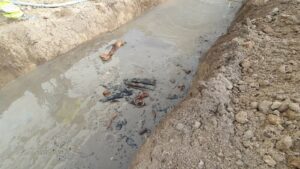
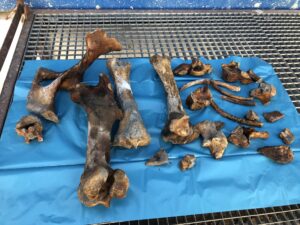
The rib bones were followed by experts – they were not rinsed out, however, but informed about the find by the client. “They looked at the horse and dated it, but didn’t find it as interesting as the rest of us.”
Sometimes you come across material that cannot be pierced or rinsed out. If the obstacle is too hard, the drill breaks off – just like with DIY drilling in your own home when you hit a steel wall. When that happens, you try again a little further away. If that doesn’t work either, you change position again, but once again it wasn’t possible to drill any deeper. “At some point we noticed that the obstacle was spreading over a larger area, so we ame back with an excavator.” A slab came to light, and the whole thing turned out to be a bunker. In Berlin, where underground bunkers are not too unusual, “people from the Berlin Underworlds came by.” The association deals with the research and maintenance of underground facilities, organizes tours through bunkers, deals with war relics – “but they said that we could tear it away because it was not interesting.“
“Unusual things like that are often found in excavation pits in the center of Berlin ” Hendrike puts into perspective. Sayings like „Have we found the amber room now?“ are plentiful. One regularly hears stories from colleagues about spectacular things that were found years ago.
Risk of confusion and explosion
As a former theater of war it is not uncommon to come across weapons in Berlin in addition to bunkers, Hendrike remembers the story of a colleague: “In Berlin, before any work in the ground can be done, a firefighter has to carry out an explosive ordnance survey.” In the special case the sounding did not yield any alarming results, so the surprise was great “when the excavator made the excavation and threw the earth on the truck. It looked very strange” – and turned out to be a bomb. As a result, the city and the S-Bahn were closed and the probability that the explosive device could go off was assessed, the type of bomb was determined, etc. “The bomb stayed on the truck and was driven to a place for old people Bombs. “
What – after a previous exploration of form and magnetic image – looks like an ordnance does not always have to be one. In Hendrike’s case, potentially explosive devices have always turned out to be fire extinguishers. She has seen such finds three or four times. “In Berlin there are a lot of things that were simply buried by rubble due to the war,” says Hendrike. Fire extinguishers still worked with a different extinguishing agent in the 1940s (carbon tetrachloride was used until the 1950s, when it was discovered that it damages the nervous system and internal organs – and also helps to deplete the ozone layer), but they were already of a very similar form like today.

Well, well, well, what have we here?
Old wells are less exciting. “They go down into a certain depth and ensure that we cannot close our soles,” says Hendrike. But that is more annoying than spectacular. “We recently dug up an old battery, but unfortunately no diamond deposits yet. But what often happens and what you wouldn’t expect in Berlin: We often find amber. The biggest that was found was the size of a child’s head. “
Even though the amber is not washed to the surface in a beautiful, bright orange color, it is still easily recognizable to the trained eye, says Hendrike. The fossilized tree resin always occurs in relation with coal, which is foundin the Berlin underground. Highly drilled coal is easy to identify due to its black color and fibrous structure. As soon as they spot coal, „the boys are more attentive.”

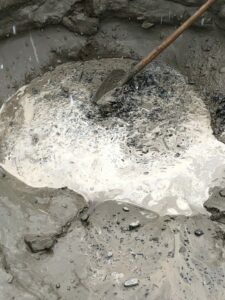

Fop or stop
When Hendrike is informed that a bomb has been found, her first question is “mostly whether it’s true or whether you’re kidding me – someone will try that all the time, we all have fun at work after all.” Once the authenticity of a bomb has been confirmed, it is clarified where the find was made and who has already been informed, so that Hendrike can take the necessary steps and contact the responsible authorities.
Depending on how big the find is and where it is located on the construction site, you can either continue working elsewhere or the construction process will be stopped – until the respective authorities have finished their investigations. “It always depends on how the authorities react. If the find catches their interest and they let archaeologists come to see it, then it will take time. “
In the case of projects that initially require an okay from city policy to begin with, everyone usually wants it to be built and completed as quickly as possible afterwards. “Nobody wants it to drag on forever.” If you can’t work, but staff and equipment still have to be paid, you can work out how long you can afford a construction freeze, says Hendrike, who is currently looking after a construction pit for a sole of around 6,500 square meters.
Quite a lot of underground in which to find hidden treasures.
We keep our fingers crossed that it will be the Amber Room!
*****
Dear Hendrike, thank you for your time and expertise – and above all your patience. It’s exciting to see what comes to light during a conversation about DSV in Berlin. Bunkers, bombs and bones, I really didn’t expect that.
About Hendrike Gramatke:
Hendrike Gramatke was born in Lower Saxony, but has lived in Berlin ever since she began her dual studies more than ten years ago. The now 32-year-old went straight to civil engineering after completing her degree in civil engineering. At that time she made a conscious decision to work in a classic male domain. Her love for jeans and sneakers instead of skirts and high heels has paid off, as those would probably not be pracitcal on the construction site.
